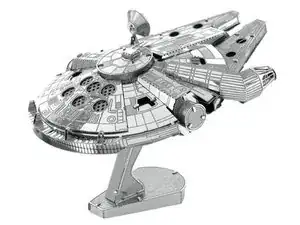
3D Puzzle How to Assemble Star Wars Millennium Falcon 3D Metal Model Replacement
Es werden einige allgemeine Werkzeuge verwendet, um an diesem Gerät zu arbeiten. Du wirst nicht jedes Werkzeug für jeden Vorgang benötigen.
The first jigsaw puzzle was thought to have been created by John Spilsbury, a London mapmaker. Spilsbury cut around the borders of countries on a map using a fine-bladed saw. These puzzles were used for the educational purpose of teaching British children geography. When the treadle saw was introduced in 1880, the modern jigsaw puzzle received its name, though the pieces were not actually cut by a jigsaw. In the early 1900s, both wooden and cardboard jigsaw puzzles were made available by the process of die-cutting where thin strips of metal with sharpened edges are pressed down on cardboard to make pieces.
The first commercially-available three-dimensional puzzles were sold under the brand name “Puzz 3D” by Hasbro. Hasbro’s three-dimensional jigsaw puzzles were first sold in 1991. Unlike traditional, flat, jigsaw puzzles, the Puzz 3D series of puzzles were made of plastic foam with part of an image printed on stiff paper glued to the foam piece. When assembled, these 3D puzzles create a standing structure.
A mechanical puzzle is another type of puzzle presented as a set of mechanically interlinking pieces in which users must manipulate the whole object or parts of the object. These mechanical puzzles include toys such as Rubik’s Cubes.